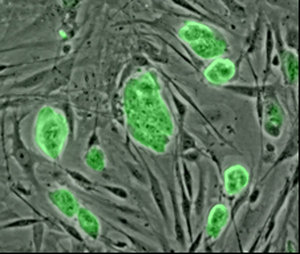Researchers in the field of bioinformatics from Tel Aviv University and the Scripps Institute reveal in today's article in the online version of Nature a method to identify pluripotent stem cells and differentiate them from relatively limited stem cells

An international research team led by researchers from the Scripps Institute in San Diego and Tel Aviv University has developed a new method for identifying pluripotent stem cells. The pluripotent cells, including embryonic stem cells, can differentiate (become after appropriate stimulation) into all types of human cells. The use of these cells may be of great help in the development of personalized medicines for the patient and in the treatment of a large number of serious diseases, such as Parkinson's and multiple sclerosis. The study is published on August 24 in the early online edition of the scientific journal Nature.
Using Illumina technology from San Diego, the researchers created a broad database describing the expression patterns of all genes in about 150 types of human cells. The researchers discovered a great similarity between all the pluripotent cells tested, while the gene expression in the other cell types was much more diverse. Further analysis of the data led to the discovery of a protein network active in pluripotent cells, which is one of the building blocks of the molecular mechanism that allows these cells a unique ability to differentiate.
The latest developments in stem cell research have led to the development of methods that allow completely sorted cells, such as skin cells, to be transformed into pluripotent cells. These developments raise the importance of the definition of pluripotency, especially in human cells, where for ethical reasons the range of possible treatments is limited. For comparison, in order to test the ability to differentiate in mouse cells, the cells can be injected into embryos and check whether certain tissues are formed from them.
"Until now, there has been no corresponding ethical way in which it is possible to prove that a human cell is pluripotent," says Dr. Franz-Josef Müller, a researcher at the Scripps Institute and the University of Kiel in Germany. "There have been many reports on human cell cultures with different differentiation abilities, but until now there was no practical way to characterize pluripotency in human cells."
The discovery is the result of a long-term study led by Prof. Loring from the Scripps Institute, in which researchers used innovative methods to measure the expression levels of all the genes in the cell, in order to characterize different groups of carefully selected stem cells. The cells included pluripotent cells with unlimited differentiation capabilities and multipotent cells, which can differentiate into a more limited repertoire of cell types (such as nervous system stem cells). In addition, sorted cells from donors and sorted cells generated from pluripotent cells were characterized.
For an in-depth analysis of the data, cutting-edge bioinformatic methods were developed in Prof. Ron Shamir's group at the Labatnik School of Computer Science at Tel Aviv University, by doctoral student Igor Olitsky. These methods were used to identify expression patterns that uniquely characterize pluripotent stem cells. The researchers found that these patterns also characterize mouse embryonic stem cells and human eggs. In addition, the developed methods made it possible to describe the protein network whose activity is identified with unlimited differentiation capacity.
"This network can only be identified by connecting all the pieces of the puzzle:" says Prof. Ron Shamir, "the diverse collection of cell types, the comprehensive measurements of gene expression levels in them, and the extensive information on protein-protein relationships accumulated in the scientific community. In recent years we have been developing computational methods for the combined analysis of diverse data on all the genes and proteins in the cell. When we adapted these methods to the needs of the project, we got the image of the network that characterizes the pluripotent cells."
In the next step, the researchers intend to investigate the control mechanism of the found protein network and how it can be used to advance medical treatment in humans.

3 תגובות
Good question. That's how it always is at the beginning of a field, but you can't demand heart surgery without opening the chest without there being thousands of open heart surgeries (just a hypothetical example) just like today you don't build a 10,000 times stronger computer all at once and solve all the problems of upgrades, but let us sweat and waste money generation after generation.
Regarding cord blood conservation.
If it is possible to multiply stem cells or if there are already stem cells in the living human body (in wisdom teeth, or in the skin, or anywhere else) then why do every health fund advertise taking fetal blood for about NIS 7,000? After all, they still don't know what to do with the stem cells When sick, and when they knew then they would probably already be able to create stem cells.